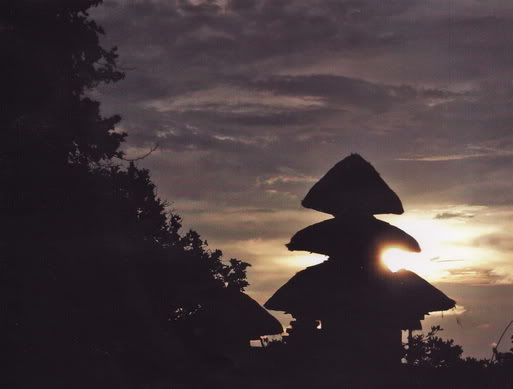
From the top of the cliff that towers above the legendary surf breaks of Southern Bali, I could see the turquoise water smash on the rocks and enter the caves which were used by the Japanese to defend Bali from the allies military attack at the end of world war II. Dramatic and soundless as the waves are so far below.
Uluwatu (ulu means land's end and watu means rock, so it is not to hard to see where Uluwatu came from), is about 45 minutes drive from Nusa Dua or one and half hour drive from Kuta. And comprises jungles, cliffs, and the vast deep blue ocean. The southern tip of Bali is rightly famous for its magical sunset at the temple located right at the edge of the majestic sea cliffs.
I arrived at the temple around five in the evening, my mission to see its famous sunset. There is an official entrance fee to enter, sarongs are available for rental next to the ticket-window and must be worn to comply with the temple rules. I followed the track till the end then turned right to the edge of a cliff, and there it was the temple perched on the edge of the cliff on my right side. The sky was overcast but there was some rays of light streaking out from narrow gaps between the dark grey clouds. Hundreds of meters below, the Indian Ocean reflected the dying sun light, on its soundless waves. As the sun went down, the scene became even more dramatic.
Uluwatu temple, its correct name is Pura Luhur Uluwatu, is one of the Sad Khayangan the six most important temples in Bali. It is dedicated to Rudra, the God of the Storm, the Wind, and the Hunt, and is one of those that Pedanda Sak'i Wawu Rauh, a priest from Java who came to Bali in A.D. 1546, built The temple and its surroundings are considered as one of the very sacred sites in the island.
 The deep blue ocean surrounds the majestic cliffs on the sea side but the natural forest is also still there on the land side. When I walked through the jungle path, I was struck by really bad smell, nauseating in fact, later on I found out that the jungle is home to a number of Rafflessia arnoldii, giant flowers which grow close to the soil and spread the smell of rotting flesh when it is blooming. Little did I know how privileged I was!.
The deep blue ocean surrounds the majestic cliffs on the sea side but the natural forest is also still there on the land side. When I walked through the jungle path, I was struck by really bad smell, nauseating in fact, later on I found out that the jungle is home to a number of Rafflessia arnoldii, giant flowers which grow close to the soil and spread the smell of rotting flesh when it is blooming. Little did I know how privileged I was!.The natural jungle is also home for some families of monkey. Precautionary signs have been put at a few places to remind visitors about their aggressiveness.The ticket officer and even my driver also reminded me of the same thing. I didn't experience any problems with the monkeys because I hid my glasses and accessories in my bag, but I did see how the"monkey scam"works. One Japanese tourist was concentrating to get shots of the temple when a monkey came and quickly snatched his specs. A local man came to help, approaching the monkey with fruit to be exchanged with the specs. He didn't ask for anything from the unlucky Japanese but another approached the tourist and told him to give the "hero"some money for his services. Could it be this wasn't a real accident but a bit of monkey business?. The reason I am telling you is just to remind you to be careful.
But now the real action starts on this marvelous spot. It is the Kecak Fire Dance.The performance started at 6pm. the half circle wooden theater was full of people, the evening sunlight was peeping from behind the dark grey clouds, and part of the sky not covered by cloud slowly turned fire red itself. It was a marvelous sight. Then more then twenty men entered the stage while creating a mesmerizing chant. Cak..cak...cakcakcak...!. The magic had started.
The southern part of Bali with its dramatic rocky peninsula, remains a must visit site, even though the thick grey cloud hung on the sky covering the sun through the evening, my visit was still wonderful.The darkness of the night finally fell when the show over. Mission accomplished.
No comments:
Post a Comment